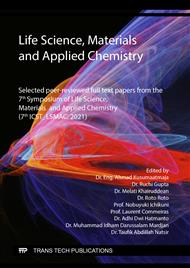[1]
J.L. Havlin, S.L. Tisdale, W.L. Nelson, J.D. Beaton, Soil Fertility and Fertilizers: An Introduction to Nutrient Management, 7th Edition, Pearson, Canada, (2005).
Google Scholar
[2]
E. Corradini, M.R. de Moura, L.H.C. Mattoso, A preliminary study of the incorporation of N-P-K fertilizer into chitosan nanoparticles, Express Polym. Lett. 4 (2010) 509–515.
DOI: 10.3144/expresspolymlett.2010.64
Google Scholar
[3]
M.E. Trenkel, Slow and Controlled Release and Stabilized Fertilizers: An Option for Enhancing Nutrient Use Efficiency in Agriculture, International Fertilizer Industry Association (IFA), France, (2010).
Google Scholar
[4]
A. Olad, H. Zebhi, D. Salari, A. Mirmohsen, A.R. Tabar, Slow-release N-P-K fertilizer encapsulated by carboxymethyl cellulose-based nanocomposite with the function of water retention in soil, Mater.Sci.Eng,C. 90 (2018) 333-340.
DOI: 10.1016/j.msec.2018.04.083
Google Scholar
[5]
I. Kartini, E.T. Lumbantobing, S. Suyanta, S.Sutarno, Bioplastic Composite of Carboxymethyl Cellulose/N-P-K Fertilizer, Key.Eng Mat. 840(2020) 156-161.
DOI: 10.4028/www.scientific.net/kem.840.156
Google Scholar
[6]
E.I. Pereira, F.B. Minussi, C.C.T da Cruz, A.C.C. Bernardi, C. Ribeiro, Urea-Montmorillonite-Extruded Nanocomposites: A Novel Slow-Release Material, J.Agric.Food.Chem. 60 (2012) 5267-5272.
DOI: 10.1021/jf3001229
Google Scholar
[7]
M. Mollan, Historical Overview in Pharmaceutical Extrusion Technology, Marcel Dekker, Inc., New York, pp.1-18, (2003).
Google Scholar
[8]
K.A. Adekola, Engineering Review Food Extrusion Technology and Its Applications,J. Food Eng. 6 (2016) 149-168.
Google Scholar
[9]
M.P. Adinugraha, D.W. Marseno, Haryadi, Synthesis and characterization of sodium carboxymethylcellulose from cavendish banana pseudo stem (Musa cavendishii LAMBERT), Carbohydr. Polym. 62 (2005) 164-169.
DOI: 10.1016/j.carbpol.2005.07.019
Google Scholar
[10]
A. Bortolin, F.A. Aouada, L.H.C. Mattoso, C. Ribeiro, Nanocomposite PAAm/Methyl Cellulose/Monmorillonnie Hydrogel: Evidence of Synergistic Effect for The Slow-Release of Fertilizers,J.Agric.Food.Chem. 61 (2013) 7431-7439.
DOI: 10.1021/jf401273n
Google Scholar
[11]
K. Rop, G.N. Karuku, D. Mbui, I. Michira, N. Njomo, Formulation of Slow-Release N-P-K Fertilizer (Cellulose-Graft-Poly (Acrylamide)/Nano-Hydroxyapatite/Soluble Fertilizer) Composite and Evaluating its N Mineralization Potential, Ann. Agric. Sci. 63 (2018) 163–172.
DOI: 10.1016/j.aoas.2018.11.001
Google Scholar
[12]
S. K. Moosvi, K. Majid, T.Ara, Studying the electrical, thermal, and photocatalytic activity of nanocomposite of polypyrol with the photoadduct of K3[Fe(CN)6] and diethylenetriamine, Mater.Res. (2016).
DOI: 10.1590/1980-5373-mr-2015-0786
Google Scholar
[13]
M. Poletto, H.L. Ornaghi, B. Neelakantaprasad, G. Rajarajan, Native cellulose: Structure, characterization and thermal properties, Materials. 7 (2014) 6105-6119.
DOI: 10.3390/ma7096105
Google Scholar
[14]
Q. Qian, Q. Chen, M. Machida, H. Tatsumoto, K. Mochidzuki, A. Sakoda, Removal of organic contaminants from aqueous solution by cattle manure compost (CMC) derived activated carbons, Appl. Surf. Sci. 255 (2009) 6107-6114.
DOI: 10.1016/j.apsusc.2009.01.060
Google Scholar
[15]
M.N. Hafiza, M.I.N. Isa, Solid Polymer Electrolyte Production from 2- Hydroxyethyl Cellulose: Effect of Ammonium Nitrate Composition on its Structural Properties, Carbohydr. Polym. 165 (2017) 123-131.
DOI: 10.1016/j.carbpol.2017.02.033
Google Scholar
[16]
S. Rimdusit, S. Jingjid, S. Damrongsakkul, S. Tiptipakorn, T.Takeichi, Biodegradability and property characterizations of Methyl Cellulose: Effect of nanocompositing and chemical crosslinking, Carbohydr.Polym. 72 (2008) 444-455.
DOI: 10.1016/j.carbpol.2007.09.007
Google Scholar
[17]
D. Chopra, R. Siddique, Kunal, Strength, Permeability and Microstructure of Self-Compacting Concrete Containing Rice Husk Ash, Biosyst. Engi. 130 (2015) 72-80.
DOI: 10.1016/j.biosystemseng.2014.12.005
Google Scholar
[18]
D.J. Sarkar, A.Singh, P.Manal, A. Kumar, B.S. Parmar, Synthesis and Characterization of Poly (CMC-g-cl-PAam/Zeolite) Superabsorbent Composites for Controlled Delivery of Zinc Micronutrient: Swelling and Release Behavior, Polym-Plast.Technol. Eng. 54 (2015) 357 – 367.
DOI: 10.1080/03602559.2014.958773
Google Scholar
[19]
Y.S. Ho, G. McKay, The Sorption of Lead (II) Ions on Peat, Wat. Res, 33 (1999) 578-584.
DOI: 10.1016/s0043-1354(98)00207-3
Google Scholar
[20]
R. Gouda, H. Baishya, Z. Qing, Application of mathematical models in drug release kinetics of Carbidopa and Levodopa ER Tablets, J. Dev. Drugs. 6 (2017) 1-8.
DOI: 10.4172/2329-6631.1000171
Google Scholar



